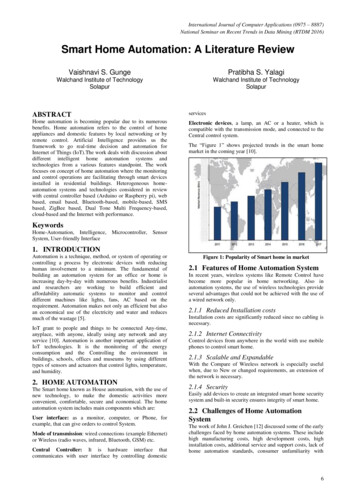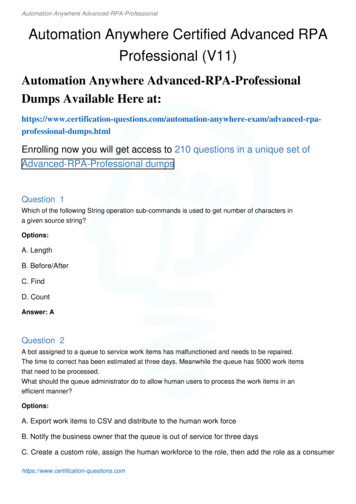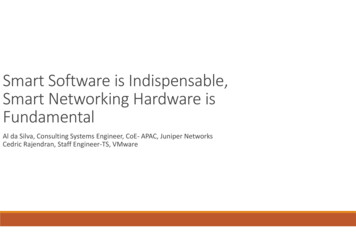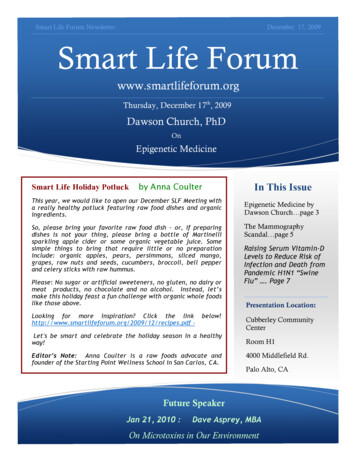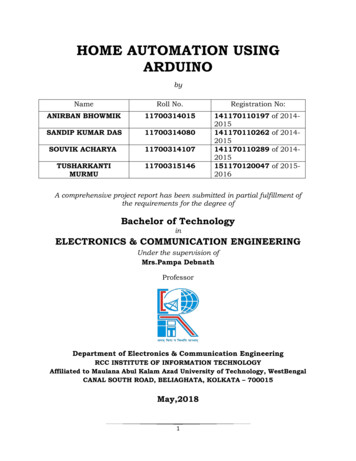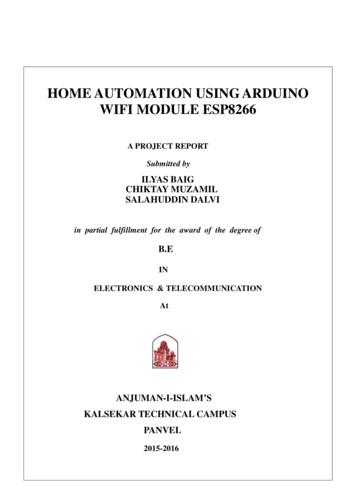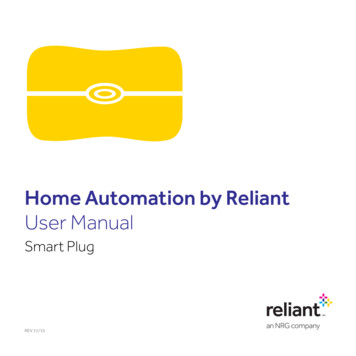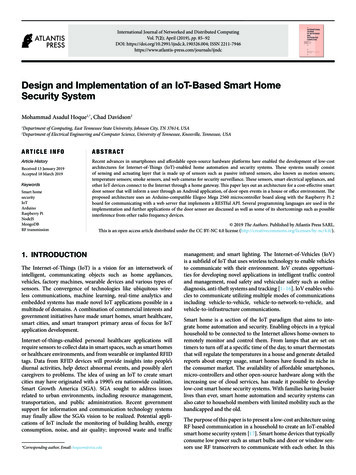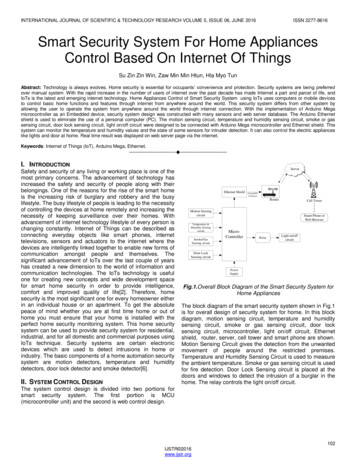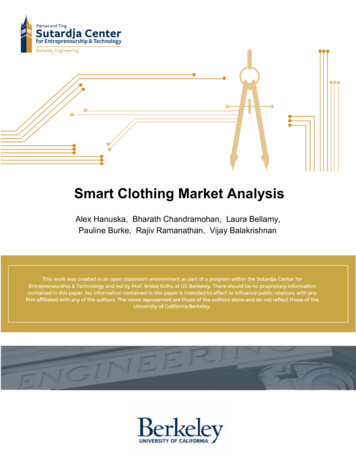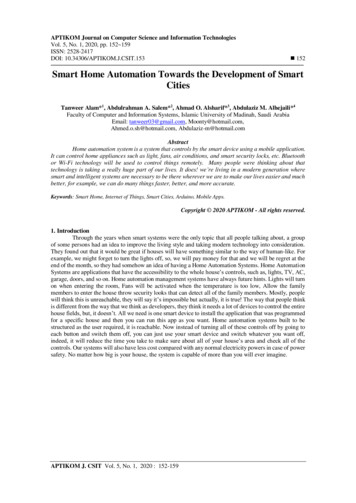
Transcription
APTIKOM Journal on Computer Science and Information TechnologiesVol. 5, No. 1, 2020, pp. 152 159ISSN: 2528-2417DOI: 10.34306/APTIKOM.J.CSIT.153 152Smart Home Automation Towards the Development of SmartCitiesTanweer Alam*1, Abdulrahman A. Salem*2, Ahmad O. Alsharif*3, Abdulaziz M. Alhejaili*4Faculty of Computer and Information Systems, Islamic University of Madinah, Saudi ArabiaEmail: tanweer03@gmail.com, Moonty@hotmail.com,Ahmed.o.sh@hotmail.com, Abdulaziz-m@hotmail.comAbstractHome automation system is a system that controls by the smart device using a mobile application.It can control home appliances such as light, fans, air conditions, and smart security locks, etc. Bluetoothor Wi-Fi technology will be used to control things remotely. Many people were thinking about thattechnology is taking a really huge part of our lives. It does! we’re living in a modern generation wheresmart and intelligent systems are necessary to be there wherever we are to make our lives easier and muchbetter, for example, we can do many things faster, better, and more accurate.Keywords: Smart Home, Internet of Things, Smart Cities, Arduino, Mobile Apps.Copyright 2020 APTIKOM - All rights reserved.1. IntroductionThrough the years when smart systems were the only topic that all people talking about, a groupof some persons had an idea to improve the living style and taking modern technology into consideration.They found out that it would be great if houses will have something similar to the way of human-like. Forexample, we might forget to turn the lights off, so, we will pay money for that and we will be regret at theend of the month, so they had somehow an idea of having a Home Automation Systems. Home AutomationSystems are applications that have the accessibility to the whole house’s controls, such as, lights, TV, AC,garage, doors, and so on. Home automation management systems have always future hints. Lights will turnon when entering the room, Fans will be activated when the temperature is too low, Allow the familymembers to enter the house throw security looks that can detect all of the family members. Mostly, peoplewill think this is unreachable, they will say it’s impossible but actually, it is true! The way that people thinkis different from the way that we think as developers, they think it needs a lot of devices to control the entirehouse fields, but, it doesn’t. All we need is one smart device to install the application that was programmedfor a specific house and then you can run this app as you want. Home automation systems built to bestructured as the user required, it is reachable. Now instead of turning all of these controls off by going toeach button and switch them off, you can just use your smart device and switch whatever you want off,indeed, it will reduce the time you take to make sure about all of your house’s area and check all of thecontrols. Our systems will also have less cost compared with any normal electricity powers in case of powersafety. No matter how big is your house, the system is capable of more than you will ever imagine.APTIKOM J. CSIT Vol. 5, No. 1, 2020 : 152-159
154 APTIKOM J. CSITISSN: 2528-2417Figure 1. Home Automation System Block Diagram2. Literature ReviewThe Internet of Things(IoT) during the last few years was used so widely in the smart housesystems. By controlling almost all appliance and security. The system consists of Arduino Uno Board, PIRsensor, temperature sensor, gas sensor, power select, and web applications. GSM is used to communicatethe microcontroller and the web page and facilitates energy management. It also monitors the type of deviceencountered at home and activates the operations. The sensor parameters will be stored in the cloud. Thesystem also can be used in mobile health care, traffic management, and so others. In the 21st century, therewas a man that had an idea which allowed him to access all the devices. Now we can even access theinternet with only one click. Home automation is a mobile application for safety and proper use of a human.In the last 10 or more years ago, we used to switch the home appliances manually. Based on the difficultaccess. At the beginning of this new automation, it was not considered an effective method yet. Astechnology has improved this system to control by Bluetooth modules. The problem with using Bluetoothis that it has a limit of the wireless range, also a chance of interference with other devices using Bluetooth.In advance, they made this kind of automation to be used using Android by android mobile phones. Lately,they figured out a system that can control and monitor the home appliances using any device which has aninternet connection.In the last years, home automation has achieved a really great job and increased the comfy of alifestyle. Smartphones are used to control all of their home appliances. You can communicate with all thehome’s controls using a smart device including new techniques. We never forget how the home automationhas extremely grown, these systems have been created to improve the comfortability of a lifestyle especiallyfor those who are elderly and disabled these systems are designed by using a single controller that owns theability control interconnected appliances such as lights, TVs, and so on. The most interesting thing is thatyou can control all of these appliances easily by using smartphones. Home automation systems could becontrolled throw some methodologies such as Bluetooth and Wi-Fi. Bluetooth is a technique that is securedand low cost as well. The hardware will be using an Arduino BT board and cell phone is wirelessly usingBluetooth. The smartphone uses the application that allows the user to control these appliances. The systemalso uses passwords to make sure it’s not going to be used by some others.Voice recognition also implemented by a researcher. Android OS has a built-in voice recognizingfeature ability to control the home appliances from user voice commands. The application converts thevoice into a text after that it sends that message to Bluetooth module that is connected to the Arduino. Thegreat thing of this voice application transmit is that the user only needs to pronounce the application namethrow the microphone and say the commands that he wanted to do such as turn the light ON or OFF. Byusing this kind of home control, the user doesn’t have to do anything except saying the words that theapplication will recognize to achieve these commands.In this research, they've explained how the home automation system works. this system works in smartdevices using android application and gives the user some services to make this technology easy forAPTIKOM J. CSIT Vol. 5, No. 1, 2020 : 152-159
155 APTIKOM J. CSITISSN: 2528-2417controlling the house. These services are connected and used by connecting the smart devices via Bluetoothtechnology but it can handle only 24 devises at most at the same time with more than 100m range ofBluetooth signals. but the problem in this research is that the signal has a limited range to be controlled andit will not work with a big distance, also, it’s not supported by Wi-Fi.Figure 2. Home Automation System Structural Diagram3. Smart Home Automation System ComponentsThe following are the main components of Smart Home Automation System. User interface Smart device Arduino Android application-based Wi-FiEven though the system has the security part which is more I like, it can detect the family membersusing scan face by saving them in the database and recall that part while scanning, so it will immediatelyopen the door when any member of the family is there. During the calculation of the percentage and ofhaving a large amount of wasted electricity power in the last few years, and some other information thatthe current systems have. Our aim is to have the ability to let everyone lives on his own lifestyle, erasingthe fear of thieves and the shock after looking at the energy bill. No matter how hard we will work, nomatter how much they want us to risk, our point is walking away after recognizing the perfect smile ofthose users we have. We would define the problem as follow: 1. The common property of success and the ability to make the house as less energy cost as possiblesuch as having the safety power mood that will detect if there is no one inside a room for a coupleof minutes it will immediately shut the power off.2. The tragedies happened to houses by thieves at late nights especially when the owners are not therebecause of their house doesn’t provide any security systems.The home automation systems will provide the need and the user requirements to handle all ofthese problems and tragedies that could happen in life. Sometimes we can do something to handle theseproblems. But, sometimes we’re so far away from home. Therefore, the best way to think about while youhave this situation is by using these modern systems, and it will be as follow: 1.2.3.4.5.6.The system will reduce power consumption.The system will also reduce manual power.The system will work efficiently and effectively.The system will work in real-life time.The system is a real challenge for people.The system has also powerful security.Smart Home Automation Towards the Development (Tanweer Alam)
156 APTIKOM J. CSITISSN: 2528-24177. The system will also include scanning cameras to support both cases which are recognizing thefamily members and recording any sense of the presence of other people who are rounding thehouse.In order to fill the gap of wasting the power of electricity in the houses, we have the idea of savingthis cost of electricity which has been a problem in the last few years. Also, the security needed, especiallywhen the owners are far away from home in case of traveling or other reasons. Two main objectives willbe covered along with this project:1.2.Building an application to control the houses’ appliances.Based on Wi-Fi connecting the house with the application.The Functional Requirements are summarized as follows.1. Ability to process data according to user choice.2. Ability to apply the user commands immediately.3. Ability to switch on and off the power.4. Ability to recognize family members.5. Ability to access Arduino using a smartphone. The nonfunctional requirement is as follows.6. Accuracy.7. High security.4. Software Development MethodologyIn this research, we use waterfall model, " It defines some basic tasks, which are carried out insequence requirements definition, architecture design, detailed design, implementation, componentverification, integration verification, and requirements validation. Each task results in documents or otherartifacts that are used as specifications for the next task, e.g. the detailed design specification forms thebasis for implementation task. In the "ideal" form, one task should be completed before the next starts.There are however variants with overlapping tasks, and these are probably used more in reality.Implementation starts when some of the detailed design is ready, component tests when components areimplemented. The following tools are used in the development of the system.circuito.io : is a software that uses to design the block diagrams and electronic circuits.Tinkercad : It is a software that uses to design the hardware.draw.io : It is used to design UML diagrams.Erdplus : is used to design an entity relationship diagram.Figure 4. Use case diagram between User and Smart AppAPTIKOM J. CSIT Vol. 5, No. 1, 2020 : 152-159
157 APTIKOM J. CSITISSN: 2528-2417The following hardware is required to develop the home automation system. Smart Device: tablets or any smart device. Connection: Which can be supported by Bluetooth or Wi-Fi. Arduino Uno board: to connect the appliances with the system.The Following Software required Android studio: to create the interfaces, and implementation of the program. Operating system: Android. Arduino software: upload the codes into the Arduino board. Database: SQL server management studio to creating the database.Figure 5. Activity diagram of the systemdevelopment community with a stable and common design language that could be used to develop andbuild computer applications" (bell.2003) In this report, we use three types of UML models, which are:Use case diagram: "A use case illustrates a unit of functionality provided by the system the main purposeof the use-case diagram is to help development teams visualize the functional requirements of a system,including the relationship of "actors" (human beings who will interact with the system) to essentialprocesses, as well as the relationships among different use cases.Activity diagram: "Activity diagrams show the procedural flow of control between two or more classobjects while processing an activity.Entity Relationships Diagram: "is used for describing data and the relationship between different entities ina database. It creates a visual map outlining process requirements and detailing connections among entitiesand their attributes.Block Diagram: a high-level diagram used in engineering too. It’s also used to create new systems orimproving an existing system.Smart Home Automation Towards the Development (Tanweer Alam)
158 APTIKOM J. CSITISSN: 2528-2417(a)(b)(c)Figure 6. Interfaces of smart appAPTIKOM J. CSIT Vol. 5, No. 1, 2020 : 152-159
159 APTIKOM J. CSITISSN: 2528-2417Our system has made to help the oldest and disabled people. It can be used by many users as it shows inthe report. The system is created to do whatever the user wants for controlling the house’s equipment usinga smart device that can be supported by our programming language.5. CONCLUSIONSmart systems are a designation that is given to the people which make their lives easier to improve thequality and execution, this research aims to provide a new hybrid solution for smart houses that is combinemobile application and an Arduino, because Smart houses are always focusing on leveling up the
Faculty of Computer and Information Systems, Islamic University of Madinah, Saudi Arabia Email: tanweer03@gmail.com, Moonty@hotmail.com, Ahmed.o.sh@hotmail.com, Abdulaziz-m@hotmail.com Abstract Home automation system is a system that controls by the smart device using a mobile application. It can control home appliances such as light, fans, air conditions, and smart security
